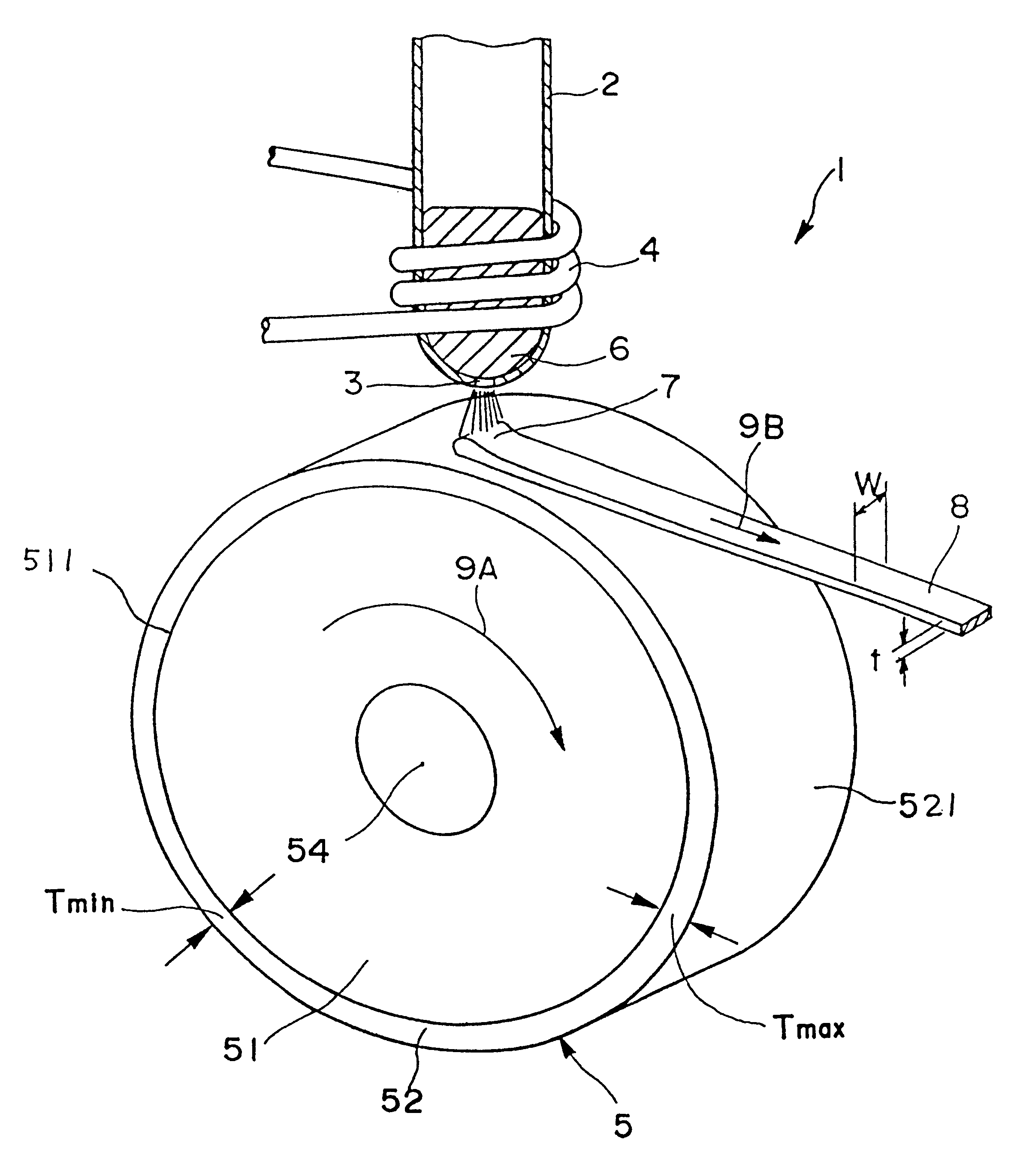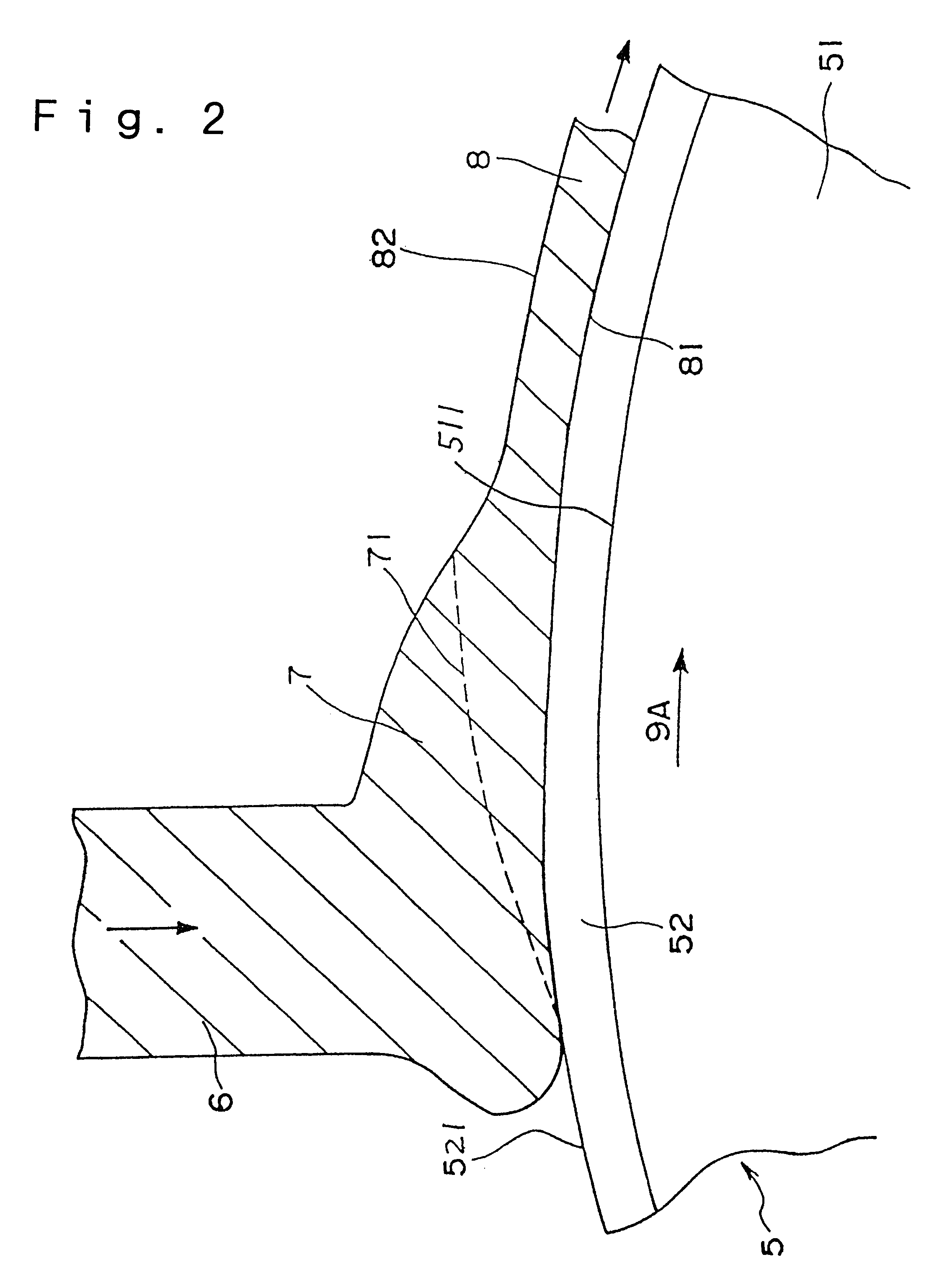Cooling roll, method for manufacturing magnet material, ribbon shaped magnet material, magnetic powder and bonded magnet
a cooling roll and ribbon shaped technology, applied in the direction of magnetic materials, magnetic bodies, inorganic material magnetism, etc., can solve the problems of large difference in cooling rate at different sites on the surface layer, deterioration of magnetic properties, and inability to obtain stable magnetic properties
- Summary
- Abstract
- Description
- Claims
- Application Information
AI Technical Summary
Benefits of technology
Problems solved by technology
Method used
Image
Examples
example 1
A quenched ribbon with an alloy composition of (Nd.sub.0.9 Dy.sub.0.1).sub.8.9 Fe.sub.bal Co.sub.7.8 B.sub.5.6 Al.sub.0.7 was obtained by the method described below.
Each starting material of Nd, Fe, Co, B and Al was weighed, and the mixture was melted in an Ar gas to mold into a mother ingot, followed by cutting a sample with a mass of about 15 g.
A quenching type ribbon manufacturing apparatus with the construction as shown in FIG. 1 was prepared, and the sample was placed into a quartz tube having a nozzle (an orifice) at its bottom.
Each cooling roll 5 having respective surface layers 52 (Nos. 1 to 3, and 6) was obtained by the chemical vapor deposition (CVD) method on the circumference face of a roll base (200 mm in diameter and 30 mm in width) made of copper. Chemical vapor deposition was a heat CVD method. An appropriate synthetic reaction gas was selected depending on the material of the surface layer. The CVD temperature was about 800 to 1500.degree. C., although it is varied ...
example 2
After subjecting the quenched ribbons obtained in the condition Nos. 1 to 6 in Example 1 to a heat treatment at 680.degree. C. for 300 seconds, these quenched ribbons were pulverized to obtain magnetic powders.
X-ray diffraction was performed at a diffraction angle range of 20.degree. to 60.degree. using Cu-K.alpha. line for analyzing the phases of the magnetic powder obtained. It was possible to confirm a R.sub.2 (Fe.Co).sub.14 B type phase as a hard magnetic phase and a .alpha.-(Fe, Co) type phase as a soft magnetic phase, and these phases were confirmed to form composite microstructured (nano-composite microstructure) from the observation by a transmission type electron microscope (TEM).
The mean particle size of the magnetic powder obtained is shown in Table 3.
An epoxy resin (a binder resin) and a small amount of a hydrazine based antioxidant were mixed with each magnetic powder obtained as described above, and bonded magnet compositions (compounds) were prepared by kneading the m...
example 3
A quenched ribbon 8 with an alloy composition of (Nd.sub.0.7 Pr.sub.0.2 Dy.sub.0.1).sub.9.0 Fe.sub.bal Co.sub.8.0 B.sub.5.7 Si.sub.0.5 was obtained by the method described below.
A mixture of starting materials comprising Nd, Pr, Dy, Fe, Co, B and Si was at first weighed, and was melted in an induction melting furnace under the argon gas to melt and mold into a mother ingot. A sample with a mass of about 15 g was cut from the ingot.
Then, the quenching type ribbon manufacturing apparatus 1 was prepared, and the sample was placed into a quartz tube having a nozzle (circular orifice) 3 at the bottom.
A grinding and polishing processing was applied on the circumference face of the roll base (200 mm in diameter and 30 mm in width) made of copper, and six kinds of the roll bases 51 with a desired surface roughness Ra each were manufactured. The grinding processing was applied using a cylindrical grinding machine or a lathe, and buff polishing was also applied. A specular surface treatment w...
PUM
| Property | Measurement | Unit |
|---|---|---|
| surface roughness | aaaaa | aaaaa |
| thickness | aaaaa | aaaaa |
| radius | aaaaa | aaaaa |
Abstract
Description
Claims
Application Information
 Login to View More
Login to View More - R&D
- Intellectual Property
- Life Sciences
- Materials
- Tech Scout
- Unparalleled Data Quality
- Higher Quality Content
- 60% Fewer Hallucinations
Browse by: Latest US Patents, China's latest patents, Technical Efficacy Thesaurus, Application Domain, Technology Topic, Popular Technical Reports.
© 2025 PatSnap. All rights reserved.Legal|Privacy policy|Modern Slavery Act Transparency Statement|Sitemap|About US| Contact US: help@patsnap.com



